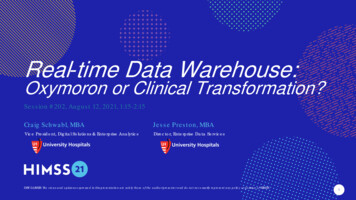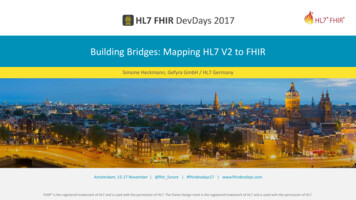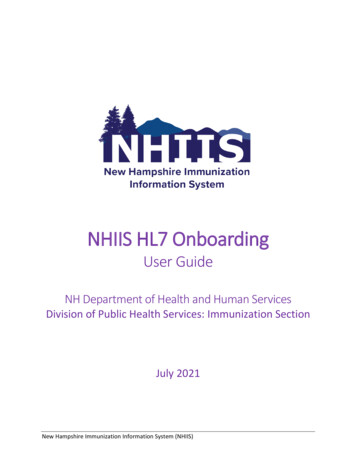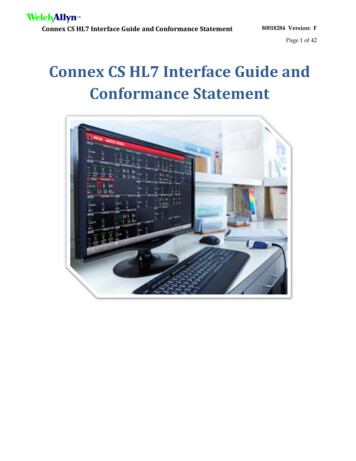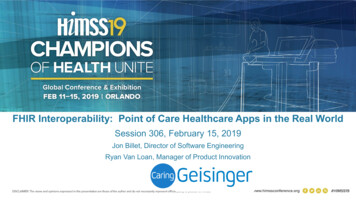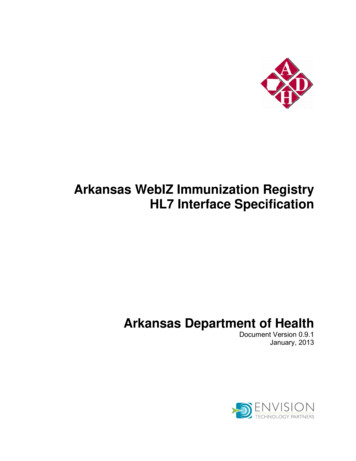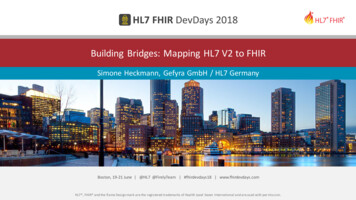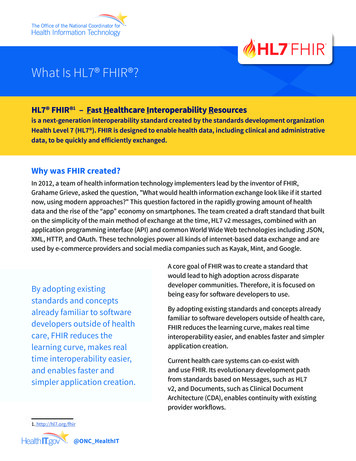
Transcription
What Is HL7 FHIR ?HL7 FHIR 1 – Fast Healthcare Interoperability Resourcesis a next-generation interoperability standard created by the standards development organizationHealth Level 7 (HL7 ). FHIR is designed to enable health data, including clinical and administrativedata, to be quickly and efficiently exchanged.Why was FHIR created?In 2012, a team of health information technology implementers lead by the inventor of FHIR,Grahame Grieve, asked the question, "What would health information exchange look like if it startednow, using modern approaches?" This question factored in the rapidly growing amount of healthdata and the rise of the “app” economy on smartphones. The team created a draft standard that builton the simplicity of the main method of exchange at the time, HL7 v2 messages, combined with anapplication programming interface (API) and common World Wide Web technologies including JSON,XML, HTTP, and OAuth. These technologies power all kinds of internet-based data exchange and areused by e-commerce providers and social media companies such as Kayak, Mint, and Google.By adopting existingstandards and conceptsalready familiar to softwaredevelopers outside of healthcare, FHIR reduces thelearning curve, makes realtime interoperability easier,and enables faster andsimpler application creation.1. http://hl7.org/fhir@ONC HealthITA core goal of FHIR was to create a standard thatwould lead to high adoption across disparatedeveloper communities. Therefore, it is focused onbeing easy for software developers to use.By adopting existing standards and concepts alreadyfamiliar to software developers outside of health care,FHIR reduces the learning curve, makes real timeinteroperability easier, and enables faster and simplerapplication creation.Current health care systems can co-exist withand use FHIR. Its evolutionary development pathfrom standards based on Messages, such as HL7v2, and Documents, such as Clinical DocumentArchitecture (CDA), enables continuity with existingprovider workflows.
What Is HL7 FHIR ?Core capabilities of FHIRFHIR’s API2 is a RESTful, or REpresentationalState Transfer, approach to data exchange.The philosophy behind FHIR isREST defines categories of data, or “Resources 3,”to create a set of Resources that,to exchange data. The philosophy behind FHIRis to create a set of Resources that, individuallyindividually or in combination,or in combination, satisfy most common usesatisfy most common use cases.cases. The Patient Resource, for example,includes demographic data related to a patient,such as their name, address, and phonenumber. Resources also improves granular data retrieval, so that a request returns just the relevantdata rather than a full record or document that itself must then be searched.Once they are modified for specific requirements using FHIR’s built-in capabilities, combinations ofResources are brought together in an Implementation Guide to address a specific use case, such as aprovider directory or patient-reported outcomes. This structure lends itself well to expansion beyondFHIR’s core capabilities.Like many other components in the standard, FHIR uses modern security standards, includingfor authentication and encryption. Similarly, among FHIR’s privacy capabilities, FHIR can supportlabeling sensitive information so that only those who have the need and the right can see it.Health care data is represented by many sets of vocabularies, terminologies, and codes which growand change over time. As a result, it is important for the data exchanged to be equally understoodby the sender and receiver, which is known as “semantic interoperability.” FHIR manages the useof this data by including references to code definitions used for data verification and by allowingrestrictions on the codes that can be used.2 See “The FHIR API” Fact Sheet3 See “Introduction to FHIR Resources” Fact SheetInterested in learning more about FHIR?See more of our Fact Sheet series logy/standards/fhir-fact-sheets.ONC’s FHIR Fact Sheets are a collaborative effort with HL7 to help educate and demystify FHIR for federalemployees. These fact sheets summarize the key technical concepts that make up the foundation of FHIR, howit is developed in an open and public process, and why FHIR adoption has become the focus of the health ITstandards world. Full details and developer documentation can be found at HL7’s FHIR website.@ONC HealthITHL7, FHIR and the [FLAME] mark are the registeredtrademarks of Health Level Seven International.
The FHIR APIHL7 FHIR includes specifications for an Application Programming Interface, or API, based onestablished web standards and modern information exchange that has been extended to createa full interoperability solution for health care. The use of common and widespread technologieslowers the barriers to entry for using the standard by making it easier and faster to implementwhile also opening up development to individuals who do not have health care expertise.What is an API?An API is an entry point, or “interface,” that allows a computer program or system to access the featuresand data of a different program or system. This entry point defines how data must be formatted and thetypes of interactions supported, such as how data can be searched. To be successfully exchanged andready for an operation, data must be formatted in the same way. For example, a data field to be used incalculations cannot accept both “1” and “one” as entries, as they cannot be interpreted the same way.APIs can be simple, with rigid definitions of data structure, or complex, with different data structures for awide array of interactions. The FHIR API mainly involves the access and exchange of data.Many modern applications, both desktop and mobile, use APIs to retrieve, store, and update data.For example, a smartphone banking app requests a user’s data from a financial institution throughthe institution’s API. Each institution’s API defines the standards and protocols that allow an externalapplication to access the institution’s data. With the proper security procedures and protocols, the appcan successfully request the user’s data. Ultimately, the user of the banking app can view their data, fromaccounts at multiple institutions, in one place.What is REST?Many applications run on a mobile device or web browser use the information exchange standard REST(Representational State Transfer) as the basis for their APIs. REST is a method of exchanging informationusing the World Wide Web standard transfer protocol HTTP1 , the underlying internet standard that formsthe basis for all website data exchange. “Http” can be seen at the beginning of every webpage’s webaddress, such as “http://www.healthit.gov”.REST means that each request from any client and response from the server contains all the informationnecessary to service the request. The exchange of data using REST is termed a “RESTful” exchange. ARESTful Resource creates a way to access data through a specific endpoint, using specific structures andformats. More strictly defined structures and formats enable more-precise data exchange. In FHIR, whichuses such strictly defined structures, a system can target and retrieve just a single data element ratherthan receive a document containing a patient’s full record.1. Hypertext Transfer Protocol@ONC HealthIT
The FHIR APITo initiate data exchange through an API, the requesting client, such as a smartphone app or server, firstsends a request via HTTP for information. If the information is available, the remote server responds witha status code indicating success and returns the information in a standard web format. For example,when a user searches for a location in Google Maps, which uses REST, the web browser is the client. Arequest in the web browser looks like the following:https://www.google.com/maps/place/1500 S Capitol St SE, Washington, DC 20003That tells Google a specific location is being searched for in the Maps system. The request is broken downas follows:https://www.google.com/maps – the receiving system (Google) and application (maps)/place/ – the Resource (place) that is the end point being queried1500 S Capitol St SE, Washington, DC 20003 – the address the user is interested inGoogle's Maps application accepts this request and sends back the data allowing the browser to displaythe map for that area. While that functionality determines what a user experiences, many RESTfulrequests are made in the background in response to the initial request, including loading the basic mapinterface, displaying the many map elements, and showing notations for other businesses in the area.The FHIR RESTful APIFHIR uses REST as the basis for data exchange in its API. Health care data types such as medications,observations, and patients are represented by their own Resources. Resources can be requested via aRESTful HTTP command like the Google Maps example above, in addition to interactions like searches orrequests that can be used to find and retrieve the precise information needed. Servers, like those behindan electronic health records system, are programmed with the types of Resources and interactionsthey can support. Third-party applications using the FHIR API can be integrated into an EHR and feedinformation directly into the provider's workflow.Each request using the FHIR API supplies the Resource and an indicator, command, or parameter thatspecifies the data needed. The simplest FHIR request returns one Resource of information, like a singlePatient. In addition, a request could return a bundle of information, such as that Patient’s associatedCarePlan and Medications, or a bulk data bundle, like all data on all Patients in an EHR. The request isstructured to tell the application what types and how much of the data are needed.REST does not directly address privacy and security elements such as authentication and authorization,which are addressed separately in the FHIR standard.By using the REST architectural style, FHIR takes the best of existing health information technologyand common internet standards to create a modern method of interoperability. This allows health caresystems to implement FHIR without steep learning curves and leading to faster application design.@ONC HealthITHL7, FHIR and the [FLAME] mark are the registeredtrademarks of Health Level Seven International.
FHIR Version History and MaturityHL7 FHIR has evolved through four releases since its initial presentation in May 2012. It hasgrown from a true draft standard with 49 Resources to its current 145 and continues to expand.In that time the standard has improved and changed to meet the needs of the health informationtechnology community.Draft Standard for Trial Use 1 (DSTU1)FHIR’s first publication in September 2013 showed a new way forward for health care data exchange. DraftStandard for Trial Use 1 had 49 resources and focused on two use cases, creating a Personal Health Recordon a mobile device and the retrieval of documents, such as encounter or discharge notes, to a mobile device.This initial release sparked the community’s interest in expanding FHIR to cover a wider variety of health careand health IT needs.Draft Standard for Trial Use 2 (DSTU2)FHIR grew in market acceptance with the publication of the Draft Standard for Trial Use 2 in 2015. Effortsincluding the Argonaut Project developed Implementation Guides (IGs) and other technologies to supportFHIR adoption by EHR developers and other health IT entities. The structure of Resources was adjusted tomake creating extensions easier, allowing for more use cases to be covered without changes to the corestandard. New Resources were also added to support non-clinical data, including claims and benefitsprocessing.The publication of FHIR DSTU2 included thecreation of the FHIR Maturity Model (FMM).When new Resources are created, they are notimmediately ready for use in live settings; theymust be refined and tested for a variety of usesand settings. The FHIR Maturity Model establisheda set of levels that progressively measure technicaladvancement, known as maturity. Resourcematurity as defined by the FMM begins withan initial draft and achieves final status withimplementation in multiple settings. Since thematurity of the FHIR standard overall is not tied tothe maturity of Resources, Resources can move upthe maturity ladder between FHIR releases. TheFMM, which is also applied to other components ofthe FHIR standard, defines Resource stability withsix levels:@ONC HealthIT FMM0 (Draft) – The resource is still in earlydevelopment but has been accepted into the FHIRstandard. FMM1 – The Resource has no current technicalerrors and is believed to address all design goals. FMM2 – The Resource has been tested andapproved at a FHIR Connectathon with multipleFHIR-enabled computer systems tested. FMM3 – The Resource passed all quality checks andan HL7 community ballot that determines if it isready for trial use. FMM4 – The Resource has been tested forfunctionality for all intended purposes, has beenpublished in a formal HL7 publication, and isoperating in at least one prototype system. FMM5 – The Resource is in use in at least fivedistinct production systems operating in at leasttwo countries.
FHIR Version History and MaturitySubstantive changes at the FMM4 or FMM5 levels that would change usage from those already establishedor would break compatibility with existing implementations would require significant justification to beaccepted and to move forward. After FMM5, a Resource reaches “normative”1 level; at this level, futurechanges must be backwards compatible so that applications that implement those Resources aren't at riskof being broken as the FHIR standard changes.Standard for Trial Use 3 (STU 3)FHIR Standard for Trial Use 3 was released in 2017 with improvements to the core Clinical, Administrative,and Financial Resources, improvements to the Clinical Decision Support and Clinical Quality MeasureResources and a new framework for workflow and task management. Additionally, tools were introducedthat made FHIR IG creation and publication to the web easier, faster, and more unified.Release 4 (R4)As the first release with normative content, the 2019 release of FHIR Release 4 left behind the Trial Usename. Two key clinical Resources, Patient and Observation, were released as normative, along with theRESTful API, the XML and JSON formats, and nine additional Resources.In 2020, ONC published the Final Rule for the 21st Century Cures Act, establishing FHIR R4 as the standardrequired for Health IT Certification.Looking ahead to Release 5 (R5)FHIR Release 5 will see increased normative content, with over 30 Resources having been nominated bytheir HL7 Workgroups to be matured to that status. In addition, the community will continue to develop thesupportive specifications to FHIR, such as the authorization framework SMART, Clinical Decision SupportHooks (CDS Hooks), and the Bulk Data Transfer specification, which will help implementers create acomplete FHIR-based exchange of health care data.With the maturing of the FHIR IG tools and templates, better integration with public health, imaging,financial management, genomics and other fields will keep FHIR at the forefront of health IT.1. Normative, in this context, is defined as content that has been accepted by the American National Standards Institute (ANSI) as anAmerican National Standard.Interested in learning more about FHIR?See more of our Fact Sheet series logy/standards/fhir-fact-sheets.ONC’s FHIR Fact Sheets are a collaborative effort with HL7 to help educate and demystify FHIR for federalemployees. These fact sheets summarize the key technical concepts that make up the foundation of FHIR,how it is developed in an open and public process, and why FHIR adoption has become the focus of the healthIT standards world. Full details and developer documentation can be found at HL7’s FHIR website.@ONC HealthITHL7, FHIR and the [FLAME] mark are the registeredtrademarks of Health Level Seven International.
Introduction to FHIR ResourcesThe core of HL7 FHIR is a set of modular components called "Resources." These form the basicdata exchange format and model of FHIR. As of FHIR Release 4, there are 145 Resources definedacross health care domains and supporting services, a number that grows with every release.What are Resources?In FHIR, health care data is broken down into categories such as patients, laboratory results, andinsurance claims, among many others. Each of these categories is represented by a FHIR Resource,which defines the component data elements, constraints on data, and data relationships thattogether make up an exchangeable patient record. The philosophy behind FHIR is to create a set ofResources that, individually or in combination, satisfy most common use cases.Each Resource contains data elements necessary for its specific use cases and links to relevantinformation in other Resources. For example, the Patient Resource1 contains basic patientdemographics, contact information, and links to a clinician or organization stored in a differentResource. Because they are based on modern World Wide Web technologies, Resources use UniformResource Locators, or URLs (also generally known as web addresses), to be located within a FHIRsystem implementation.A Resource in its raw form does not require that most data elements be assigned a value; when it iscustomized for real-world use through the Profiling process, certain elements are then required sothat the Resource can be functional. For example, a Patient Resource may be Profiled to require thata patient’s name, address, and telephone number be supported to enable patient matching.FHIR ResourceDesign ChoicesA primary motivation behind FHIR’sdesign is to enable interoperabilitythrough well-structured datamodels that use simple andefficient exchange mechanisms.To achieve this, FHIR adopted thefollowing principles:1. http://hl7.org/fhir/patient.html@ONC HealthITReuse – FHIR Resources are designed to meetthe general needs of health care to avoid anovercomplicated and redundant Resource set.Extensions and other customizations exist to allowresources to be adapted for specific use cases (theProfiling process). FHIR Resources also link to otherResources so that complex structures can be built.Performance – Compared to previous standards,FHIR Resources are simpler in their construction,making them better-suited for exchange acrossa network and more easily understood andimplementable by developers.
Introduction to FHIR ResourcesUsability – FHIR Resources are designed to be understood by technical experts andnon-technical people alike. Even if the details of the XML/JSON format are not understood,non-technical people can view these in a browser or text reader and understandtheir contents.Fidelity – FHIR Resources have strict restrictions on intermixing of values with differing datatypes, like strings and numeric values. They can also be validated by their syntax in additionto defined sets of business rules.Implementability – A core goal of FHIR was to create a standard that would lead to highadoption across disparate developer communities. Like the entire standard, FHIR Resourcesare designed to be easily understood and readily exchanged using industry standards,common programming languages, and established data exchange technologies.Example FHIR Resource – PatientThe example below shows key parts of a Resource – the Resource used, a human readable summaryof the data, an extension with its associated data, and the structured data itself.Resource Identity& MetadataHuman ReadableSummaryExtension withURL to definitionStructured Data:»»»»MRNNameGenderBirth DateProviderInterested in learning more about FHIR?See more of our Fact Sheet series logy/standards/fhir-fact-sheets.ONC’s FHIR Fact Sheets are a collaborative effort with HL7 to help educate and demystify FHIR for federalemployees. These fact sheets summarize the key technical concepts that make up the foundation of FHIR, howit is developed in an open and public process, and why FHIR adoption has become the focus of the health ITstandards world. Full details and developer documentation can be found at HL7’s FHIR website.@ONC HealthITHL7, FHIR and the [FLAME] mark are the registeredtrademarks of Health Level Seven International.
Health Level 7 (HL7 ). FHIR is designed to enable health data, including clinical and administrative data, to be quickly and efficiently exchanged. . application programming interface (API) and common World Wide Web technologies including JSON, XML, HTTP, and OAuth. These technologies power all kinds of internet-based data exchange and are
